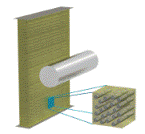Mechanical and Materials Engineering, Department of

Department of Engineering Mechanics: Dissertations, Theses, and Student Research
MULTISCALE MODELING AND SIMULATION OF NANOCRYSTALLINE ZIRCONIUM OXIDE
A Dissertation Presented to the Faculty of The Graduate College at University of Nebraska In Partial Fulfillment of the Requirements For the Degree of Doctor of Philosophy, Major: Engineering (Engineering Mechanics); Under the Supervision of Professor Ruqiang Feng
Lincoln, Nebraska: August 2009
Copyright (c) 2009 Chaojun Wang
Abstract
Nanocrystalline zirconium oxide (ZrO2) nanofibers fabricated with the sol-gel electrospinning process are expected to provide a new class of super-strong yet ultra-flexible materials. To predict their mechanical properties, we have carried out multiscale modeling and analyses. A computational model that combines the Voronoi polycrystal simulation of nanocrystalline structure with the finite element analysis has been developed. It enables the use of the first-principles predictions for the three ZrO2 crystal phases in continuum analysis of the elastic stress and strain fields in the nanofibers under uniaxial-stress tension. Calculations have been performed for each of the three phases and for various dual-phase compositions. The results and their statistical analysis show heterogeneous local elastic response even in terms of cross-sectional average. However, effective elastic properties can be meaningfully defined for the nanofibers if the length-to-width ratio of averaging unit is above 2. In comparison, the monoclinic ZrO2 nanofibers are the least heterogeneous and overall superior to the other phase compositions examined.
The tensile strength of anti-symmetrically tilted monoclinic ZrO2 bicrystals free from edge and dislocation defects has been analyzed using molecular dynamics (MD) simulation as well as Monte Carlo (MC) simulation to obtain an upper bound estimate of the strength of nanocrystalline monoclinic ZrO2, which is the least heterogeneous in nanofiber form. The MD results show that the bicrystals under high-rate tension fail through void growth in the amorphous grain boundary (GB), a ductile mechanism in contrast to brittle fracture failure in ZrO2 single crystal under tension. The dynamic strength varies from 4.7 GPa to 6.2 GPa, and it is approximately inversely proportional to the thickness of the GB. In comparison, the quasistatic strength computed with MC simulation is 10% lower, indicating relatively weak rate dependence.
To mitigate the size limitation of fully atomistic (FA) simulations, we have developed a hybrid atomistic-coarse grained technique for current multiscale bicrystal simulation. The material in a near GB region is modeled atomically with MC simulation while the material in the far regions is approximated with coarse graining elements and its free energy is described as a function of element nodal positions and temperature under the local harmonic assumption. Iterative near-region MC sampling of atom moves, far-region free energy minimization, and inter-region interaction updating lead to an equilibrium state, from which the quasistatic response of the bicrystal to prescribed global tension can be calculated. The method has been validated against FA calculations. The hybrid simulations of larger-size monoclinic ZrO2 bicrystals have enabled a convergence study on the width of bicrystal model, which is not affordable computationally with FA simulation.
Advisor: Ruqiang Feng

